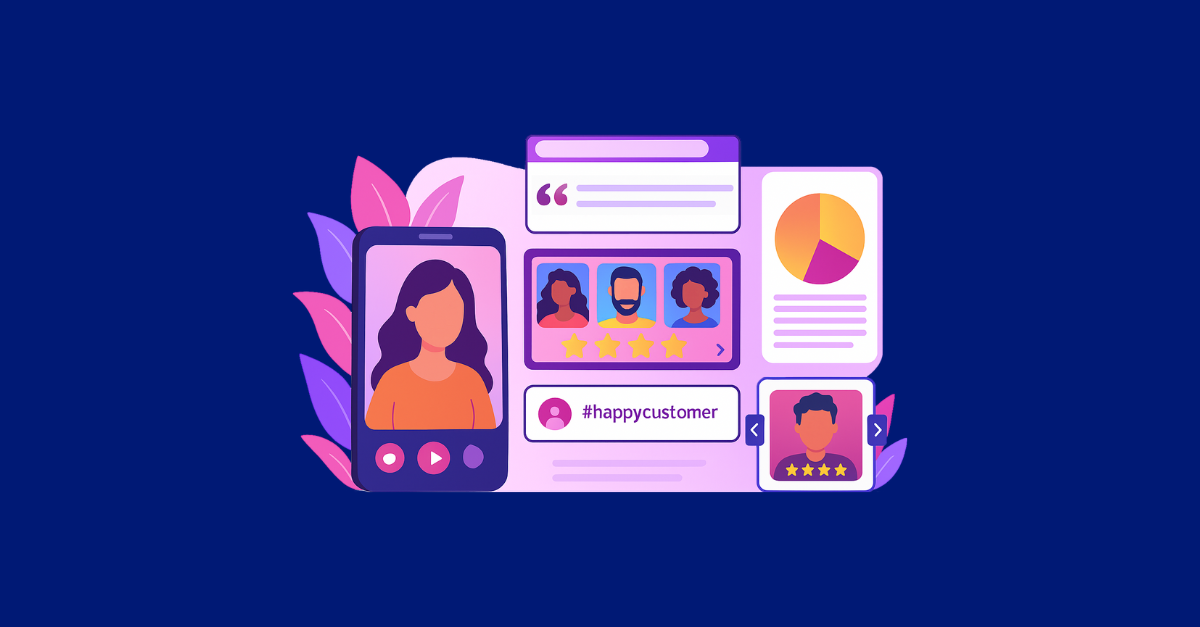UGC Ad Formats: 6 Creative Ideas for Repurposing User Content
In an era where polished brand messages often fall flat, user-generated content (UGC) offers a refreshing dose of authenticity.
If you’re already sitting on a goldmine of customer reviews, tagged photos, or social shout-outs, the next question is: how do you actually use it?
Why Format Matters in UGC Ads
Seventy-one percent of consumers stress a need to trust the brands they support… but here’s a real conundrum: that same study found that 74% of consumers avoid advertising.
To restore trust in online advertising, some brands are experimenting with user-generated content in their ads. But UGC only works when it resonates — and that involves being able to strategically decide the right format in the right context. For example, Instagram users might stop for a quick, relatable video testimonial, but that same content may not perform well in a Google Display ad. Each format has its strengths, and the most effective campaigns tailor UGC types to specific platforms and audience moments.
6 UGC Formats & How to Use Them
Some studies found that UGC generates higher engagement with ads than professionally produced content. Again, not surprising. It’s more realistic, more authentic — and people want to interact with it more.
Whether you’re running display ads, paid social, or retargeting campaigns, knowing how to shape and serve UGC is key to making it work hard for your brand. This post explores six high-impact UGC formats and creative ways to turn everyday customer content into scroll-stopping ads across channels.
Are you getting the ROI you expect from your PPC campaigns? If not, Greenlane can help.
1. Video Testimonials
Video is king for a reason: it combines visual engagement with the authenticity of real customer experiences. Video testimonials — especially those recorded by users on their phones — feel raw, believable, and personal. You can clip that content to then create video ads across all the different platforms. They’re particularly effective in bottom-of-funnel campaigns where trust is crucial to conversion.
Why it works: UGC video ads create an emotional connection and demonstrate real-life usage, often outperforming branded video. People can demonstrate the value of a product and showcase its various functionalities.
How to use it:
- Clip 15–30 second segments for Instagram Reels, TikTok, or YouTube Shorts
- Use native ad formats (like TikTok Spark Ads) to promote content from real creators
- Add subtitles and light branding to maintain authenticity while staying on message
Example: Glossier built an entire brand around UGC, and their TikTok ads frequently feature user-submitted skincare routines. These videos appear to be everyday content — because they are — and consistently outperform studio-shot assets.
Photo of Glossier Ads from Tiktok
2. Customer Photos
Authentic, real-life photos of products in use can be more persuasive than the most beautifully lit product shot. Customer-submitted images show products in context, helping potential buyers visualize ownership and relate more directly to what’s being shown.
Why it works: Photos from customers feel genuine and help others assess things about your products, like size, color, and fit. Even service-based brands can show off end results and happy customers or clients in pictures.
How to use it:
- Feature customer photos in static paid social or carousel ads
- Add overlays with star ratings or brief quotes
- Build trust by placing these images near “Buy Now” CTAs or on retargeting creatives
Example: Wayfair and IKEA both feature customer photos on product pages and occasionally in Facebook retargeting ads. Seeing how a lamp looks in a real living room might encourage hesitant buyers to make a decision.
3. Text Reviews & Testimonials
Don’t underestimate the power of a few well-chosen words. Pulling quotes from reviews can make compelling ad copy, especially when layered with visuals or product imagery. Even short phrases can pack a punch.
Why it works: Testimonials reduce risk and build credibility, especially when they reflect the audience’s own hesitations or goals. These kinds of UGC ads build trust and credibility with your product or service because they may address concerns that people may have before purchasing, which ultimately impacts the final purchase decision.
How to use it:
- Insert review snippets into headlines or descriptions for Google Search or Meta ads
- Pair with lifestyle imagery or product shots in static ads
- Use quotes as social proof in landing page hero sections
Example: Amazon’s “Customers say…” quote blocks in sponsored product listings mirror this tactic.
Photo from Amazon Product Page
Example: Marcus by Goldman Sachs pulled a quote from a client to use in this graphic advertisement below.
Photo from Marcus by Goldman Sachs Ad
4. Social Media Mentions & Hashtags
Hashtag campaigns and social mentions not only drive engagement but also create a steady stream of usable content. When people tag your brand or use your campaign hashtag, you gain access to authentic content that can be repurposed creatively. You can also use those branded hashtags and images to highlight existing positive engagement and then encourage others to share their experiences as well.
Why it works: It builds community and adds proof that “people like me” use and love your product.
How to use it:
- Curate hashtag submissions into Instagram carousels or Meta Story ads
- Feature tagged posts in highlight reels or branded campaigns
- Use aggregated content to create a social proof collage in display ads
Example: Coca-Cola’s “Share a Coke” campaign invited fans to post their personalized Coke bottles on social media. The brand then used many of those posts in their digital and outdoor ads, driving massive UGC engagement and brand affinity. It was so successful that the brand is doing it again in 2025.
5. Blog Posts, Tutorials, & Case Studies
Longer-form UGC, like blog posts and how-to content, allows for deeper storytelling and authority building. This long-form content offers more in-depth information and helps establish credibility. You could use this just by taking some quotes, putting them in your ad copy or repurposing them into your own content. This format is ideal for more complex products or services where a quick quote won’t cut it.
Why it works: Tutorials and personal stories show results and explain how your product fits into someone’s life.
How to use it:
- Pull highlights or quotes for LinkedIn or Facebook ad copy
- Repurpose longer stories into 30-second video case studies
- Point display ads to full blog posts for warmer traffic
Example: Notion often features user stories in their blog, and clips those narratives into social ads. Whether it’s a small business or a student, they use these posts to showcase real workflows that drive conversions.
6. Survey or Quiz Feedback
If you’ve ever run a quiz or post-purchase survey, you already have UGC. This data, especially free-form feedback, can provide a treasure trove of insights for your messaging and ad targeting.
Why it works: Real feedback highlights benefits and pain points in the customer’s own words.
How to use it:
- Quote survey responses in testimonial-style ads
- Use recurring pain points to shape messaging
- Segment audiences by response and personalize retargeting ads
Example: Spotify Wrapped is a masterclass in transforming user data into viral user-generated content (UGC). While it’s not “feedback” per se, it’s a great example of using customer data to power personalized (and shareable) campaigns. Here is a screen from my own 2024 Spotify Wrapped. Think of all the ways my favorite artists could be used in marketing ads for me.
Bonus Tip: Always Credit & Comply
While UGC is powerful, it’s not a free-for-all. You definitely need explicit consent when you’re using any kind of UGC. You can’t just steal people’s images and videos and use them.
Before using customer content, always:
- Get explicit permission (especially for images, videos, and quotes)
- Credit the original creator whenever possible
- Disclose sponsored or compensated content with tags like #ad or #sponsored
Not only is it the ethical route, but it actually adds credibility to your ads.
UGC Ads & Other Paid Media Services with Greenlane
UGC is more than a nice-to-have. It’s one of the most persuasive tools in your paid media toolbox — when used with intention.
Want to make UGC part of a smarter ad strategy?
Explore Greenlane’s Paid Media Services and let us help you turn customer love into high-performing campaigns.







![The Big List of PPC Resources and Articles [Updated for 2025]](https://www.greenlanemarketing.com/wp-content/uploads/2021/08/12-768x401.png)